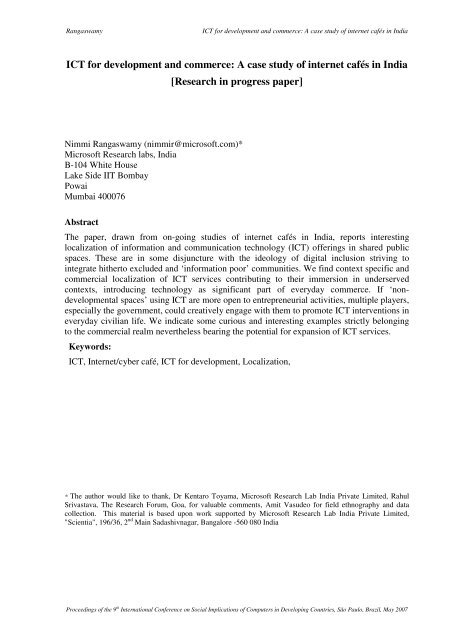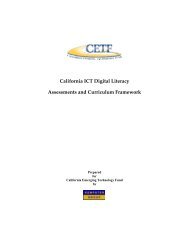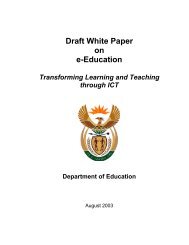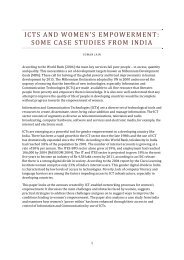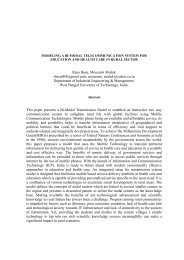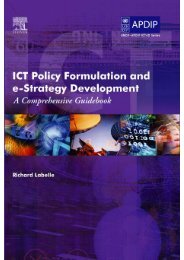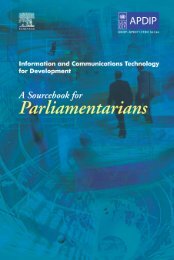ICT for development and commerce: A case study ... - Ifipwg94.org.br
ICT for development and commerce: A case study ... - Ifipwg94.org.br
ICT for development and commerce: A case study ... - Ifipwg94.org.br
You also want an ePaper? Increase the reach of your titles
YUMPU automatically turns print PDFs into web optimized ePapers that Google loves.
Rangaswamy<<strong>br</strong> />
<strong>ICT</strong> <strong>for</strong> <strong>development</strong> <strong>and</strong> <strong>commerce</strong>: A <strong>case</strong> <strong>study</strong> of internet cafés in India<<strong>br</strong> />
<strong>ICT</strong> <strong>for</strong> <strong>development</strong> <strong>and</strong> <strong>commerce</strong>: A <strong>case</strong> <strong>study</strong> of internet cafés in India<<strong>br</strong> />
[Research in progress paper]<<strong>br</strong> />
Nimmi Rangaswamy (nimmir@microsoft.com)*<<strong>br</strong> />
Microsoft Research labs, India<<strong>br</strong> />
B-104 White House<<strong>br</strong> />
Lake Side IIT Bombay<<strong>br</strong> />
Powai<<strong>br</strong> />
Mumbai 400076<<strong>br</strong> />
Abstract<<strong>br</strong> />
The paper, drawn from on-going studies of internet cafés in India, reports interesting<<strong>br</strong> />
localization of in<strong>for</strong>mation <strong>and</strong> communication technology (<strong>ICT</strong>) offerings in shared public<<strong>br</strong> />
spaces. These are in some disjuncture with the ideology of digital inclusion striving to<<strong>br</strong> />
integrate hitherto excluded <strong>and</strong> ‘in<strong>for</strong>mation poor’ communities. We find context specific <strong>and</strong><<strong>br</strong> />
commercial localization of <strong>ICT</strong> services contributing to their immersion in underserved<<strong>br</strong> />
contexts, introducing technology as significant part of everyday <strong>commerce</strong>. If ‘non<strong>development</strong>al<<strong>br</strong> />
spaces’ using <strong>ICT</strong> are more open to entrepreneurial activities, multiple players,<<strong>br</strong> />
especially the government, could creatively engage with them to promote <strong>ICT</strong> interventions in<<strong>br</strong> />
everyday civilian life. We indicate some curious <strong>and</strong> interesting examples strictly belonging<<strong>br</strong> />
to the commercial realm nevertheless bearing the potential <strong>for</strong> expansion of <strong>ICT</strong> services.<<strong>br</strong> />
Keywords:<<strong>br</strong> />
<strong>ICT</strong>, Internet/cyber café, <strong>ICT</strong> <strong>for</strong> <strong>development</strong>, Localization,<<strong>br</strong> />
* The author would like to thank, Dr Kentaro Toyama, Microsoft Research Lab India Private Limited, Rahul<<strong>br</strong> />
Srivastava, The Research Forum, Goa, <strong>for</strong> valuable comments, Amit Vasudeo <strong>for</strong> field ethnography <strong>and</strong> data<<strong>br</strong> />
collection. This material is based upon work supported by Microsoft Research Lab India Private Limited,<<strong>br</strong> />
"Scientia", 196/36, 2 nd Main Sadashivnagar, Bangalore -560 080 India<<strong>br</strong> />
Proceedings of the 9 th International Conference on Social Implications of Computers in Developing Countries, São Paulo, Brazil, May 2007
Rangaswamy<<strong>br</strong> />
<strong>ICT</strong> <strong>for</strong> <strong>development</strong> <strong>and</strong> <strong>commerce</strong>: A <strong>case</strong> <strong>study</strong> of internet cafés in India<<strong>br</strong> />
<strong>ICT</strong> <strong>for</strong> <strong>development</strong> <strong>and</strong> <strong>commerce</strong>: A <strong>case</strong> <strong>study</strong> of internet cafés in India<<strong>br</strong> />
[Research in progress paper]<<strong>br</strong> />
1. INTRODUCTION<<strong>br</strong> />
The paper, culled out of research in progress, looks at a particular configuration of <strong>ICT</strong>’s to<<strong>br</strong> />
provide critical accounts of <strong>development</strong>al initiatives in India. We report from an ongoing<<strong>br</strong> />
ethnographic <strong>study</strong> of urban <strong>and</strong> peri-urban internet cafés <strong>and</strong> rural PC kiosks. We have<<strong>br</strong> />
covered, thus far, 12 villages in rural Western India hosting a PC kiosk <strong>and</strong> ten cafés<<strong>br</strong> />
distributed amongst the suburban Mumbai metropolis, the city of Surat <strong>and</strong> Alibag town, all<<strong>br</strong> />
in western India. Our initial findings are pointing towards interesting localization of <strong>ICT</strong><<strong>br</strong> />
offerings in these public spaces <strong>and</strong> are, probably, in some disjuncture with the ideology of<<strong>br</strong> />
digital inclusion integrating hitherto excluded <strong>and</strong> ‘in<strong>for</strong>mation poor’ communities.<<strong>br</strong> />
At his stage in our <strong>study</strong>, we are exploring 3 related issues raising debates about disjunctions<<strong>br</strong> />
between in<strong>for</strong>mation <strong>and</strong> communication technologies <strong>for</strong> ‘<strong>development</strong>’ <strong>and</strong> <strong>for</strong> ‘<strong>commerce</strong>’<<strong>br</strong> />
as mutually exclusive social processes <strong>and</strong> ideologies. Firstly, <strong>ICT</strong> configurations in fairly<<strong>br</strong> />
mature urban IT ecologies display barriers to commercialization <strong>and</strong> immersion not far<<strong>br</strong> />
removed from their resource stressed rural counterparts. Secondly, context specific <strong>and</strong><<strong>br</strong> />
commercial localization of IT services equally contribute to <strong>ICT</strong> immersions in hitherto<<strong>br</strong> />
underserved contexts. Thirdly, how multiple players, especially the government, can<<strong>br</strong> />
creatively engage with <strong>ICT</strong> driven commercial spaces to promote <strong>ICT</strong> interventions in<<strong>br</strong> />
everyday civilian life.<<strong>br</strong> />
It seems pertinent to ask here, are <strong>ICT</strong> <strong>for</strong> <strong>development</strong> discourses coding the commercial <strong>and</strong><<strong>br</strong> />
non-commercial as <strong>development</strong> <strong>and</strong> non-<strong>development</strong>? Is in<strong>for</strong>mation also coded into what is<<strong>br</strong> />
good/superior or bad/inferior in<strong>for</strong>mation? If ‘non-in<strong>for</strong>mational spaces’ using <strong>ICT</strong> are more<<strong>br</strong> />
open to creative entrepreneurial activities will these be termed <strong>ICT</strong> ‘not’ <strong>for</strong> <strong>development</strong>? Is<<strong>br</strong> />
<strong>ICT</strong> <strong>for</strong> <strong>development</strong> by definition, rendered non-commercial? Debates in terms of welfare<<strong>br</strong> />
economics posit the state as major player. How does the state tap into or engage with market<<strong>br</strong> />
impulses while driving <strong>development</strong> initiatives? Commercial spaces, especially where<<strong>br</strong> />
in<strong>for</strong>mation technology is playing out, become important nodes <strong>for</strong> entrenching these<<strong>br</strong> />
technologies <strong>and</strong> extending state role in shaping these spaces.<<strong>br</strong> />
2. FOREGROUNDING DEBATES<<strong>br</strong> />
In<strong>for</strong>mation <strong>and</strong> communication technologies are viewed as heralding the onset of an<<strong>br</strong> />
in<strong>for</strong>mation society in nations <strong>and</strong> communities historically excluded from the fruits of<<strong>br</strong> />
<strong>development</strong> <strong>and</strong> progress. <strong>ICT</strong>’s are widely recognized <strong>for</strong> the contradictory twin roles they<<strong>br</strong> />
simultaneously play in society: the immense potential to meet <strong>development</strong> goals <strong>and</strong> to<<strong>br</strong> />
widen the gulf between in<strong>for</strong>mation rich <strong>and</strong> poor communities overlapping with existing<<strong>br</strong> />
socio-economic divides. They also cover a <strong>br</strong>oad range of meanings, approaches <strong>and</strong> practices<<strong>br</strong> />
from curing perennial poverty through capacity building to mushrooming back-end<<strong>br</strong> />
processing offices (BPO’s) in urban sectors generating rapid employment. But, it is<<strong>br</strong> />
universally regarded as a ‘good thing’. <strong>ICT</strong> <strong>for</strong> <strong>development</strong> is the new mantra <strong>for</strong> initiatives<<strong>br</strong> />
Proceedings of the 9 th International Conference on Social Implications of Computers in Developing Countries, São Paulo, Brazil, May 2007
Rangaswamy<<strong>br</strong> />
<strong>ICT</strong> <strong>for</strong> <strong>development</strong> <strong>and</strong> <strong>commerce</strong>: A <strong>case</strong> <strong>study</strong> of internet cafés in India<<strong>br</strong> />
to trans<strong>for</strong>m developing nations to superpowers or underdeveloped countries to clean <strong>and</strong><<strong>br</strong> />
healthy ones 1 .<<strong>br</strong> />
India is witness to rapid IT driven socio-economic boom with its GDP growth reaching all<<strong>br</strong> />
time high 2 . Indian urban l<strong>and</strong>scapes are dotted with IT parks, global support centers <strong>and</strong><<strong>br</strong> />
special economic zones. The government introduces pro-active policies to quicken the pace of<<strong>br</strong> />
economic upswing in the country. But this is barley a portion of the overall scenario. Despite<<strong>br</strong> />
a booming economy, the majority of suburban, peri-urban <strong>and</strong> rural India is yet to experience<<strong>br</strong> />
the fruits of prosperity.<<strong>br</strong> />
Seeking to gain momentum through India’s mission of digital inclusion, many such<<strong>br</strong> />
ideologically driven processes (even those driven by government <strong>and</strong> private sector<<strong>br</strong> />
partnerships), find inconsistent adoption <strong>and</strong> sustainability in communities aspiring <strong>for</strong> entry<<strong>br</strong> />
into the larger in<strong>for</strong>mation culture 3 . Nevertheless, consumption of <strong>ICT</strong> value-oriented services<<strong>br</strong> />
is growing, with 6.6 million mobile phones added in October 2006 in India 4 . In this backdrop<<strong>br</strong> />
of increasing Indians interfacing with market driven <strong>ICT</strong>, we argue that the notional<<strong>br</strong> />
preponderance of <strong>development</strong> in challenging digital exclusion, evade or turn way from social<<strong>br</strong> />
processes, not in alignment with presumed <strong>development</strong> goals, where <strong>ICT</strong>’s find better routes<<strong>br</strong> />
of immersion.<<strong>br</strong> />
To recollect a <strong>br</strong>ief history of internet in India, the government introduced the first<<strong>br</strong> />
international telecom carrier in 1995. The Indian Government has been propelling towards<<strong>br</strong> />
“in<strong>for</strong>mation age” <strong>and</strong> “convergence” by announcing enabling policies toward <strong>development</strong><<strong>br</strong> />
<strong>and</strong> progress with an ultimate goal of “Internet <strong>for</strong> All” 5 . However, implementation of some<<strong>br</strong> />
of these policies have been beset with various operational, procedural, regulatory issues <strong>and</strong><<strong>br</strong> />
supporting legal framework, which is inhibiting the reach <strong>and</strong> benefit of the Internet to masses<<strong>br</strong> />
in the country 6 .A current survey by the Internet <strong>and</strong> Mobile association of India, IAMAI, puts<<strong>br</strong> />
India’s Internet User Base At 37 Million touching 54 Million By March 2008. The e-<<strong>br</strong> />
Technology group at Indian Market Research Bureau, IMRB, felt “The next round of growth<<strong>br</strong> />
1 Following the <strong>development</strong> of India’s national strategies <strong>for</strong> <strong>ICT</strong>, the government made a concerted ef<strong>for</strong>t to <strong>br</strong>ing low-cost connectivity<<strong>br</strong> />
<strong>and</strong> <strong>ICT</strong> enabled services to the ‘rural masses’ (Pohjola 2002). Along these lines, a public-private collaborative ef<strong>for</strong>t has launched the<<strong>br</strong> />
ambitious ‘Mission 2007-Every village a knowledge centre’ <strong>for</strong> achieving a knowledge revolution in India<<strong>br</strong> />
http://www.mission2007.org/mission/ <strong>and</strong> http://www.mssrf.org/<<strong>br</strong> />
2 For a quick overview of India’s economic mobility, http://www.indianindustry.com/indian-economy/indian-economy-overview.html<<strong>br</strong> />
3 What is ignored is the actual process of <strong>development</strong>, its structural exclusions of populations, lack of committed resource supports, <strong>and</strong><<strong>br</strong> />
personnel who eschew <strong>development</strong> to corner personal gain, in short, deeper questions of socio-political contexts aiding or thwarting the<<strong>br</strong> />
actualities of progress. Kaushik <strong>and</strong> Singh (2004) Pringle (2002) speak about specific <strong>case</strong> studies in India (Thompson 2004) (Licker 2001)<<strong>br</strong> />
discuss ideological underpinnings of <strong>ICT</strong> <strong>for</strong> D. Slater <strong>and</strong> Kwami (2005) report that new media practice in Ghana is significantly opposed,<<strong>br</strong> />
or unconnected, to <strong>ICT</strong>- driven poverty reduction logics through which they are understood by those in governance <strong>and</strong> policy. Kurien 2005,<<strong>br</strong> />
point to <strong>case</strong> studies from Kerala, relating to socio- political tensions in the implementation of <strong>ICT</strong>’s <strong>for</strong> <strong>development</strong> <strong>and</strong> capacity building,<<strong>br</strong> />
particularly tensions faced by <strong>ICT</strong> entrepreneurs hoping to make business out of these initiatives.<<strong>br</strong> />
4 http://www.iht.com/articles/ap/2006/11/12/business/AS_TEC_India_Mobile_Phones.php<<strong>br</strong> />
5 The Times of India editorial, ‘Unwired World: WiMax promises high-speed mobile data <strong>and</strong> telecom services’, November 18, 2006<<strong>br</strong> />
reported Chennai to be the first WiMax enabled city in India.<<strong>br</strong> />
6 The Internet subscriber base grew very slowly from 0.01 million subscribers (1995) to 0.14 million (1998). The end of VSNL’s monopoly<<strong>br</strong> />
in 1999 led to phenomenal surge in subscriber base growth from 0.28 million (1999) to 3 million (2001). However, from April 2001<<strong>br</strong> />
onwards, growth rate started declining on all over India <strong>and</strong> reached 3.23 million (against a projected target of 4.5 million) in 2002 <strong>and</strong> 3.5<<strong>br</strong> />
million in 2003. The declining was due to low PC penetration, high Internet access costs <strong>and</strong> steep PC prices, besides poor connectivity.<<strong>br</strong> />
Despite ongoing deregulation of India’s telecommunications sector, its national teledensity is one of the lowest in the world, improving<<strong>br</strong> />
slowly from 0.06% (1990), 2.86 (2000), 3.58 (2001) <strong>and</strong> 5 (2003). The rural <strong>and</strong> urban teledensity were 0.93 <strong>and</strong> 10.16 (2001) <strong>and</strong> 1.49 <strong>and</strong><<strong>br</strong> />
15.16 (2003), respectively. Internet subscriber base in 2004 was 0.4%, in sharp contrast to Asian countries as Korea with 58, Malaysia with<<strong>br</strong> />
11 <strong>and</strong> China with 2% (Telecom Regulatory Authority of India, 2004).<<strong>br</strong> />
Proceedings of the 9 th International Conference on Social Implications of Computers in Developing Countries, São Paulo, Brazil, May 2007
Rangaswamy<<strong>br</strong> />
<strong>ICT</strong> <strong>for</strong> <strong>development</strong> <strong>and</strong> <strong>commerce</strong>: A <strong>case</strong> <strong>study</strong> of internet cafés in India<<strong>br</strong> />
will be driven by new <strong>and</strong> innovative applications such as blogs, P2P, video on dem<strong>and</strong> <strong>and</strong><<strong>br</strong> />
online gaming. While the old favorites such as email, chat <strong>and</strong> IM will drive first time users to<<strong>br</strong> />
the medium” 7 .<<strong>br</strong> />
With PC penetration being low <strong>and</strong> the bulk of urban population living <strong>and</strong> working in make<<strong>br</strong> />
shift <strong>and</strong> non-<strong>for</strong>mal economies, cafés are prime spaces that initiate first timers <strong>and</strong> <strong>br</strong>ing<<strong>br</strong> />
technology into their everyday. It is no coincidence that similar issues hindering <strong>ICT</strong><<strong>br</strong> />
deployment <strong>and</strong> immersion in rural India act as barriers in peri-urban <strong>and</strong> deep suburban<<strong>br</strong> />
regions. Power cuts are frequent <strong>and</strong> there is little by way of e-government services that coopt<<strong>br</strong> />
civilians with <strong>ICT</strong>. It is evident doing small business with <strong>ICT</strong>’s develop a certain public<<strong>br</strong> />
character dependent on larger policies, state initiatives <strong>and</strong> a techno-friendly climate unlikely<<strong>br</strong> />
to be critical <strong>for</strong> non-<strong>ICT</strong> start up businesses.<<strong>br</strong> />
In India Cyber cafés <strong>and</strong> PC kiosks have allowed new <strong>for</strong>ms of context-specific social<<strong>br</strong> />
networks to emerge. Studies from countries report specific <strong>and</strong> unconventional social<<strong>br</strong> />
<strong>for</strong>mations around public configurations of <strong>ICT</strong>’s. We noted a spurt of <strong>ICT</strong> activity around<<strong>br</strong> />
communicative functions in ethnographic findings from Ghana <strong>and</strong> Jamaica reporting<<strong>br</strong> />
different assemblages of media dependent on local needs <strong>for</strong> in<strong>for</strong>mation flows. Existing<<strong>br</strong> />
networks are often built around maintaining kin relationships bound with patterns of<<strong>br</strong> />
economic migration (Burrell <strong>and</strong> Anderson, 2006 Burrell, 2006, Slater 2000). Local<<strong>br</strong> />
demographics played a critical role in the usage of public internet assemblages in London<<strong>br</strong> />
(Wake<strong>for</strong>d 2003). A <strong>study</strong> of cyber cafés in the city of Bangalore, India, speaks of active<<strong>br</strong> />
appropriation <strong>and</strong> shaping of shared <strong>ICT</strong> spaces by youth going beyond communication<<strong>br</strong> />
agendas (Nisbett 2006).<<strong>br</strong> />
3. SHARED PUBLIC CYBER SPACES IN INDIAN SOCIAL ENVIRONMENTS<<strong>br</strong> />
Our <strong>study</strong> of cyber cafés in urban cities <strong>and</strong> towns in India show alternate uses of café space,<<strong>br</strong> />
in low-middle class locales, some with poor housing conditions <strong>and</strong> infrastructural facilities 8 .<<strong>br</strong> />
The internet user base co-exist with high levels of mobile telephony, public consumption of<<strong>br</strong> />
cable/satellite TV, <strong>and</strong> the emerging FM radio audiences. This constellation of mixed media<<strong>br</strong> />
happens within a strictly commercial <strong>and</strong> entrepreneurial framework of very small businesses<<strong>br</strong> />
with little interest in promoting <strong>ICT</strong> <strong>for</strong> <strong>development</strong>, as we underst<strong>and</strong> the term. Almost all<<strong>br</strong> />
Cafés operate under commercial business licenses no different <strong>for</strong>m those required <strong>for</strong><<strong>br</strong> />
running, say, a fast food joint. After 3 months of observations in 10 urban cafés we found<<strong>br</strong> />
three interesting activities a buzz: the chat room, stock trading <strong>and</strong> networked gaming. Each<<strong>br</strong> />
of these gain prominence in a specific social environment of a café.<<strong>br</strong> />
Our <strong>study</strong> of rural PC kiosks amidst a resource stressed <strong>and</strong> mixed communicative ecology,<<strong>br</strong> />
show continuity with certain urban consumption patters. Rural India with 600,000 strong<<strong>br</strong> />
officially defined villages is a potpourri of farming villages <strong>and</strong> village like towns with<<strong>br</strong> />
varying degrees of urbanity <strong>and</strong> infrastructural amenities. By some estimates, there are as<<strong>br</strong> />
many as 150 rural PC-kiosk projects across India. Such projects could provide the first<<strong>br</strong> />
7 http://www.iamai.in/section.php3?secid=16&press_id=1210&mon=9<<strong>br</strong> />
8 Cyber cafés numbers are dynamic constellations with no authoritative figures available. The 2004 figures put it around 50, 000, Caslon<<strong>br</strong> />
Analytics (2004) cited in Haseloff, 2005. Since debates are <strong>for</strong>mulated from early results we have yet to configure demographic <strong>and</strong> social<<strong>br</strong> />
profiles of users<<strong>br</strong> />
Proceedings of the 9 th International Conference on Social Implications of Computers in Developing Countries, São Paulo, Brazil, May 2007
Rangaswamy<<strong>br</strong> />
<strong>ICT</strong> <strong>for</strong> <strong>development</strong> <strong>and</strong> <strong>commerce</strong>: A <strong>case</strong> <strong>study</strong> of internet cafés in India<<strong>br</strong> />
computing experience <strong>for</strong> as many as 700 million people in India (Toyama 2004). A village is<<strong>br</strong> />
characterized by its farming communities but is occupationally diverse <strong>and</strong> contains a mixed<<strong>br</strong> />
communicative ecology with higher mobile coverage than l<strong>and</strong>line, huge national /satellite<<strong>br</strong> />
TV viewership <strong>and</strong> the local cinema theatre. India has a robust rural <strong>ICT</strong> policy <strong>and</strong> action<<strong>br</strong> />
<strong>and</strong> has initiated multitudinal projects to augur <strong>development</strong> initiatives through <strong>ICT</strong>. Impact<<strong>br</strong> />
assessments by various government <strong>and</strong> non-governmental agencies, are unclear about the<<strong>br</strong> />
degrees of progress in receiving communities.<<strong>br</strong> />
The 12 villages under our purview have a fairly uni<strong>for</strong>m story to tell with regard to <strong>ICT</strong> <strong>for</strong><<strong>br</strong> />
<strong>development</strong> <strong>and</strong> <strong>ICT</strong> <strong>for</strong> <strong>commerce</strong>. While Internet café <strong>and</strong> kiosk entrepreneurs have mixed<<strong>br</strong> />
interests in developing more expansive potentials of <strong>ICT</strong> driven media, the government <strong>and</strong><<strong>br</strong> />
NGOs in developing nations are focused on <strong>ICT</strong>D as mantra <strong>for</strong> progress <strong>and</strong> rhetoric <strong>for</strong><<strong>br</strong> />
<strong>for</strong>ums. The inconsistent provision of communication infrastructure including <strong>ICT</strong> hardware<<strong>br</strong> />
<strong>and</strong> maintenance without attention to the institutional <strong>and</strong> practical contexts of use of<<strong>br</strong> />
technology has resulted in skewed <strong>ICT</strong>D deployments showing little progress, empowerment<<strong>br</strong> />
or <strong>ICT</strong> literacy among the populace hoping <strong>for</strong> a take-off towards technology enabled social<<strong>br</strong> />
prowess. In their two year <strong>study</strong> of 300 rural telecentres across India, Kiri <strong>and</strong> Menon (2006)<<strong>br</strong> />
find that usage of <strong>development</strong>-oriented services, such as e-agriculture is much lower, while<<strong>br</strong> />
functioning PC kiosks are more like communication centers of the PCO/STD/ISD kind. One<<strong>br</strong> />
of our subject kiosks, a beneficiary of combined <strong>development</strong>al ef<strong>for</strong>ts by the<<strong>br</strong> />
state/NGO/corporate found the experience of running an internet kiosk in his village the most<<strong>br</strong> />
frustrating experience <strong>and</strong> stopped on-line activities. However, the kiosk operator, who runs a<<strong>br</strong> />
small Photo studio in his village, found a new mode of employing his PC! He supplies<<strong>br</strong> />
digitally made over pictures in Photoshop to many clients in his village <strong>and</strong> surrounding<<strong>br</strong> />
villages. He says”… my PC has finally come to use <strong>and</strong> I make good profits selling a single<<strong>br</strong> />
post card size print <strong>for</strong> 20 cents each…” In this little village, <strong>commerce</strong> has somewhat<<strong>br</strong> />
overtaken <strong>development</strong> ef<strong>for</strong>ts to diffuse digital technology!<<strong>br</strong> />
4. REPORTS FROM THE FIELD<<strong>br</strong> />
4.1 Barriers despite Boom<<strong>br</strong> />
Our initial findings in Mumbai suburban <strong>and</strong> deep-suburban cafés report a kind of 10 year<<strong>br</strong> />
local history of the internet. Café entrepreneurs began running these as small business,<<strong>br</strong> />
enthused by the on-set of IT driven economic boom in India. Some switched family<<strong>br</strong> />
professions, trained themselves in IT networking <strong>and</strong> hardware <strong>and</strong> began shop in earnest.<<strong>br</strong> />
Amongst our <strong>case</strong> studies, all 10 urban <strong>and</strong> 10 out of the 12 Rural entrepreneurs had an IT<<strong>br</strong> />
degree or associate diploma, one of them learnt h<strong>and</strong>s-on. All are com<strong>for</strong>table h<strong>and</strong>ling <strong>and</strong><<strong>br</strong> />
networking multiple PC’s, hardware trouble shooting. The initial boom driving the<<strong>br</strong> />
mushrooming of urban cafés has waned. Urban café operators report falling client <strong>and</strong><<strong>br</strong> />
<strong>br</strong>owsing rates, while rural kiosk operators find lack of power <strong>and</strong> infrastructural crunches<<strong>br</strong> />
having debilitating effects on <strong>ICT</strong> dispersion <strong>and</strong> services.<<strong>br</strong> />
An important concern expressed by café owners is the improbability of managing a multi-PC<<strong>br</strong> />
café with little knowledge of computing software <strong>and</strong> networking. They simply cannot af<strong>for</strong>d<<strong>br</strong> />
maintenance! This seems to be a recurring theme in the type of person/s who does business<<strong>br</strong> />
with IT. Here, skill, like doing business with any craft, is a major resource <strong>and</strong>, in this <strong>case</strong>,<<strong>br</strong> />
not bound with family or social tradition that is passed on intra-generationally but modern,<<strong>br</strong> />
Proceedings of the 9 th International Conference on Social Implications of Computers in Developing Countries, São Paulo, Brazil, May 2007
Rangaswamy<<strong>br</strong> />
<strong>ICT</strong> <strong>for</strong> <strong>development</strong> <strong>and</strong> <strong>commerce</strong>: A <strong>case</strong> <strong>study</strong> of internet cafés in India<<strong>br</strong> />
secular <strong>and</strong> attained through expensive packaged fees. Cyber café’s primary investments in<<strong>br</strong> />
computers <strong>and</strong> hardware not with st<strong>and</strong>ing, st<strong>and</strong>ing costs are the killer. It becomes<<strong>br</strong> />
indispensable that the owner is a hardware/networking/ trouble shooting specialist! Bhavesh,<<strong>br</strong> />
one of our subjects running a suburban Mumbai café, recalled his small profits, “I am an IT<<strong>br</strong> />
engineer. … I don’t have to depend on any engineer to set up the all the things I have here.<<strong>br</strong> />
…. we have to adjust the capital <strong>and</strong> costs as well. There are internet charges. There are<<strong>br</strong> />
electricity charges. The telephone bill…, <strong>and</strong> then you will be able to decide whether you’ve<<strong>br</strong> />
had a profit. … It is impossible to pay <strong>for</strong> professional help. We are the help…..”. A crucial<<strong>br</strong> />
issue that comes to light here is <strong>ICT</strong> in small businesses promote the same kind of barriers<<strong>br</strong> />
excluding the in<strong>for</strong>mation poor populace. <strong>ICT</strong> related entrepreneurship, no more than a cyber<<strong>br</strong> />
café, dem<strong>and</strong>s technology related skills. The specificities of acquiring <strong>ICT</strong> related skills<<strong>br</strong> />
initiate a <strong>br</strong>eak from traditional intra-familial passing of skills, often requiring <strong>for</strong>mal training<<strong>br</strong> />
with an acquired aptitude <strong>for</strong> technology coupled with expensive tutoring fee. The economics<<strong>br</strong> />
around acquiring IT skills excludes certain social-economic groups in developing nations like<<strong>br</strong> />
India augmenting the digital exclusion debate.<<strong>br</strong> />
Rural regions face acute infrastructural pressures to maintain on-line services. Kiosk operators<<strong>br</strong> />
experience severe constraints in ways their <strong>ICT</strong> ventures depend on extraneous players <strong>and</strong><<strong>br</strong> />
agencies. The internet becomes a very expensive <strong>and</strong> frustrating experience to both owners<<strong>br</strong> />
<strong>and</strong> clients of kiosks when hardware <strong>br</strong>eak down coupled with huge connectivity <strong>and</strong> trouble<<strong>br</strong> />
shooting issues collide with periodic power cuts. In <strong>and</strong> around Pabal district in Western<<strong>br</strong> />
India, our focus of <strong>study</strong>, 34 internet kiosks were begun in as many villages in 2001, most of<<strong>br</strong> />
them making use of government subsidy in the drive to entrench internet technologies. By the<<strong>br</strong> />
time of our <strong>study</strong>, in 2005, there are 12 functioning kiosks, 7 of them from the original 34 <strong>and</strong><<strong>br</strong> />
5 new. Kiosks ceased operations <strong>for</strong> various reasons: Some people who wanted PC’s at<<strong>br</strong> />
subsidized rates had posed as future operators <strong>and</strong> housed computers. Others sighted<<strong>br</strong> />
connectivity/hard ware issues <strong>and</strong> poor follow ups from donor agencies as promised. Many<<strong>br</strong> />
expressed serious doubts about flagging off a new <strong>and</strong> expensive technology on a population<<strong>br</strong> />
with out serious technical <strong>and</strong> market support structures (Rangaswamy, 2006).<<strong>br</strong> />
4.2Commerce despite Barriers<<strong>br</strong> />
In this section, we highlight commercial transactions in public <strong>and</strong> shared cyber spaces that<<strong>br</strong> />
take specific, context-related <strong>for</strong>ms.<<strong>br</strong> />
Multiple players have staked claims to shape the course of kiosk <strong>development</strong> in the country.<<strong>br</strong> />
Corporates players like n-logue, Drishtee, <strong>and</strong> ITC’s e-chaupal program have drawn on <strong>for</strong>profit<<strong>br</strong> />
business models <strong>for</strong> long term sustainability. Meanwhile, several non-profits in this<<strong>br</strong> />
space argue <strong>for</strong> large government funded infrastructural investments in the diverse<<strong>br</strong> />
communication ecologies of 600,000 villages in India 9 . Based on our studies we argue that<<strong>br</strong> />
‘imagination around <strong>ICT</strong> needs to go beyond its singular role as a <strong>development</strong>al tool, to<<strong>br</strong> />
address a <strong>br</strong>oader spectrum of needs in the complex socio-cultural world of rural<<strong>br</strong> />
communities’ (Rangaswamy 2006). <strong>ICT</strong>’s as commercial tools are <strong>br</strong>inging profits <strong>and</strong> hope<<strong>br</strong> />
of sustainability. We are seeing PC services supporting dem<strong>and</strong> <strong>for</strong> image/visual services like<<strong>br</strong> />
digital photography <strong>and</strong> videography rather than provide conventional ‘in<strong>for</strong>mation’ services.<<strong>br</strong> />
9 Kumar 2004, Dhawan 2004, Jhunjhunwala 2000, 2001<<strong>br</strong> />
Proceedings of the 9 th International Conference on Social Implications of Computers in Developing Countries, São Paulo, Brazil, May 2007
Rangaswamy<<strong>br</strong> />
<strong>ICT</strong> <strong>for</strong> <strong>development</strong> <strong>and</strong> <strong>commerce</strong>: A <strong>case</strong> <strong>study</strong> of internet cafés in India<<strong>br</strong> />
Kiosk operators have shown immense drive in sniffing out commercial possibilities that were<<strong>br</strong> />
though non existent. As an example, the operator in Kendur village, Popu 12,000, has<<strong>br</strong> />
attached the printer/Xerox/scanning suite to his PC with no on-line activity <strong>br</strong>inging money.<<strong>br</strong> />
But his main profits come from digital mixing. He uses pirated Photoshop <strong>and</strong> has a good<<strong>br</strong> />
consistent clientele <strong>for</strong> these pictures. He charges 20 Cents <strong>for</strong> a post card size digitally mixed<<strong>br</strong> />
photo. “My clients love the mixing work. They are now giving me ideas to change the look<<strong>br</strong> />
<strong>and</strong> feel of their photos…” Another KO in the urbanizing village of Uruli Kanchan, Popu<<strong>br</strong> />
50,000, said ‘There are 9 hour power cuts here… what kind of on-line services I can offer… I<<strong>br</strong> />
have a flourishing computer training institute…. I use a generator during power cuts”.<<strong>br</strong> />
Our on-going research in urban Western Indian regions, cyber cafés reported untenablility of<<strong>br</strong> />
st<strong>and</strong> alone business. Initial enthusiasm <strong>and</strong> excitement around internet cafés have waned to<<strong>br</strong> />
accommodate these as secondary business. At least 6 out of the 10 cafés we looked at ran a<<strong>br</strong> />
small PC assemblage <strong>and</strong> maintenance attached to café business, while 2 had mobile retail<<strong>br</strong> />
services. These businessmen viewed the twin engagements as complimentary <strong>br</strong>inging steady<<strong>br</strong> />
clients <strong>and</strong> easy propag<strong>and</strong>a <strong>for</strong> selling PC’s via the internet clientele. Vinod, who runs a<<strong>br</strong> />
suburban Mumbai café, assembles PC’s <strong>for</strong> a small neighbourhood market said, “Definitely it<<strong>br</strong> />
is unviable…. Only a cyber café is not a revenue earner. You have to have another business in<<strong>br</strong> />
place. If you want to earn good money, difficult. Yes, you can <strong>br</strong>eak even. It will over come<<strong>br</strong> />
cost. But just a cyber café is not a good revenue earner. You have to have some other business<<strong>br</strong> />
in parallel. For example, in my <strong>case</strong> hardware would <strong>br</strong>ing me profit <strong>and</strong> café earnings would<<strong>br</strong> />
manage the expenses…”. Bhavesh added “Café is more like a supplementary business apart<<strong>br</strong> />
from my hardware business <strong>and</strong> would be an additional source of revenue. In the sales phase<<strong>br</strong> />
I can do hardware selling, sales, plus café …” Vinod articulates reasons, “….. People are<<strong>br</strong> />
becoming more internet savvy. Schools introduce computers at a very early grade…. They all<<strong>br</strong> />
want a home PC. In a city like Mumbai where connectivity is good <strong>and</strong> <strong>br</strong>oad b<strong>and</strong> rates are<<strong>br</strong> />
crashing cyber cafés are loosing out. I switched to assembling PC’s <strong>and</strong> that is doing better<<strong>br</strong> />
business. I sold 50 the last year… <strong>and</strong> my <strong>br</strong>owsing rates have come down by 30 % ...”<<strong>br</strong> />
There is a second example of internet cafés trans<strong>for</strong>ming to residuary business. A café in<<strong>br</strong> />
south Mumbai, close to the stock exchange hub, is run by Pankaj, another IT engineer who<<strong>br</strong> />
opened the café to trade stocks “…. Our prime business is trading with the National Stock<<strong>br</strong> />
Exchange <strong>and</strong> the Bombay Stock Exchange (NSC, BSE). And the cyber café is actually part<<strong>br</strong> />
time business. ….it is not just the cyber café that we operate here… the 4-5 PC’s are idle after<<strong>br</strong> />
4 PM, because the market is open <strong>for</strong> trading up to the time,… so to utilize the PC’s we<<strong>br</strong> />
started the cyber café. …This is a market place. In this locality you won’t find any cyber café.<<strong>br</strong> />
At least around 5 to 10 meters. So we expect income, though it’s just a month old café...”<<strong>br</strong> />
A third <strong>and</strong> prominent scenario is the cyber café cum gaming centre making business from<<strong>br</strong> />
individual or networked PC gaming. Radhe, who manages <strong>and</strong> owns an internet café in a<<strong>br</strong> />
Mumbai suburban slum speaks about his business maneuvers “…, I started a communication<<strong>br</strong> />
centre, PCO/STD/ISD <strong>and</strong> thought of beginning internet. We got 5 PC’s. …. Not much came<<strong>br</strong> />
by way of income from internet. We still made money only from telephony, especially longdistance….The<<strong>br</strong> />
space opposite our house is occupied by a coin operated gaming parlor with a<<strong>br</strong> />
huge rush <strong>for</strong> games from local children <strong>and</strong> youth. I thought of the potential <strong>for</strong> LAN based<<strong>br</strong> />
games. Now we have lots of children <strong>and</strong> youth coming to play games. This is a lower middle<<strong>br</strong> />
class neighbourhood with the University situated close by <strong>and</strong> we keep charges low <strong>for</strong> both<<strong>br</strong> />
gaming <strong>and</strong> internet. We are finding clients only <strong>for</strong> games…The odd client comes <strong>for</strong><<strong>br</strong> />
internet…”<<strong>br</strong> />
Proceedings of the 9 th International Conference on Social Implications of Computers in Developing Countries, São Paulo, Brazil, May 2007
Rangaswamy<<strong>br</strong> />
<strong>ICT</strong> <strong>for</strong> <strong>development</strong> <strong>and</strong> <strong>commerce</strong>: A <strong>case</strong> <strong>study</strong> of internet cafés in India<<strong>br</strong> />
Lastly, <strong>and</strong> curiously, the internet, more then catering to purposive clients <strong>for</strong> <strong>br</strong>owsing,<<strong>br</strong> />
searching, mailing, has spawned a growing ‘chat room’ user base, particularly in suburban<<strong>br</strong> />
Mumbai. It is still too early in our research to delineate the social character of the chat room<<strong>br</strong> />
interactive space <strong>and</strong> its user protagonists but early results are generating interesting social<<strong>br</strong> />
profiles of users 10 . Thus far, the users are predominantly male, 18-22, showing habitual<<strong>br</strong> />
chatting with ‘new on-line friends’ <strong>and</strong> tending towards enacting/per<strong>for</strong>ming an alternate,<<strong>br</strong> />
imagined ‘on-line personality’. Pankaj, the café owner, comments on why chat rooms differ<<strong>br</strong> />
from normal face to face friendships“…You can’t call any one or just talk to a stranger on the<<strong>br</strong> />
road. …. But in a chat room you can ask <strong>for</strong> ‘arbitrary introductions’ <strong>and</strong> if any one is<<strong>br</strong> />
interested then he/she will reply. But the problem with personal interaction is that there is<<strong>br</strong> />
always that fear of it back firing. And in personal interaction what happens is that you can<<strong>br</strong> />
see the other person <strong>and</strong> vice versa, but here you can describe yourself at first to be Brad Pitt<<strong>br</strong> />
<strong>and</strong> then the reality could be that you are Danny Di Vito… but by then you are already<<strong>br</strong> />
friends”.<<strong>br</strong> />
Here is a conversation we had with Sagar, a frequent chat room visitor, living in a deepsuburb<<strong>br</strong> />
of Mumbai. He had something to say about ‘taking’ identities on-line,<<strong>br</strong> />
“Interviewer- Ok. You are telling me that through chats like this it is easier to approach boys<<strong>br</strong> />
or girls because we don’t know the person <strong>and</strong> he/she is prone to giving false ID’s.<<strong>br</strong> />
Sagar - Yes it is easy to do so….. It’s not real.<<strong>br</strong> />
I - Then what is the use if the ID is not real?<<strong>br</strong> />
S - You cannot depend on it ever… That you’ll find someone true to what he projects.<<strong>br</strong> />
…because one friend had told me that he himself has made an ID with a girl’s name <strong>and</strong> uses<<strong>br</strong> />
it to chat up with boys just <strong>for</strong> ‘time pass’ (to kill time).<<strong>br</strong> />
I - What are you saying?<<strong>br</strong> />
S - Yes he stays just here, in this neighbourhood. Though I will not tell you his name”<<strong>br</strong> />
5. CONCLUDING REMARKS<<strong>br</strong> />
Contextual adoption of <strong>ICT</strong>’s is perceived to be somewhat off-beat seen through a<<strong>br</strong> />
‘<strong>development</strong>’ lens. These are real adoptions in the face of inconsistent <strong>and</strong> irregular<<strong>br</strong> />
infrastructural supports. What lessons do they have <strong>for</strong> those of us alert to IT diffusion in<<strong>br</strong> />
varied social environments? Where <strong>ICT</strong>’s are engaged in everyday life through small<<strong>br</strong> />
businesses cropping around its usage, a good example being the independent cyber cafés,<<strong>br</strong> />
what can government initiatives do to augment these further? Can commercial offerings<<strong>br</strong> />
around <strong>ICT</strong>’s be given special status through special licenses or promotional regulation to aid<<strong>br</strong> />
business prepositions. This way the government ensures pro-active engagements with market<<strong>br</strong> />
impulses converting these to viable spaces both <strong>for</strong> <strong>commerce</strong> <strong>and</strong> diffusion of technology.<<strong>br</strong> />
These are early inferences <strong>and</strong> articulations in the hope of making fuller <strong>and</strong> robust<<strong>br</strong> />
recommendations based on in-coming data <strong>and</strong> reflections from on-going field work.<<strong>br</strong> />
10 The Times of India, November 19, 2006 (Sunday supplement) reports social networking sites going beyond<<strong>br</strong> />
the usual dating/business networking to giving voices to otherwise suppressed issues, <strong>and</strong> the ‘young <strong>and</strong><<strong>br</strong> />
restless’, getting confident about their sexual profiles.<<strong>br</strong> />
Proceedings of the 9 th International Conference on Social Implications of Computers in Developing Countries, São Paulo, Brazil, May 2007
Rangaswamy<<strong>br</strong> />
<strong>ICT</strong> <strong>for</strong> <strong>development</strong> <strong>and</strong> <strong>commerce</strong>: A <strong>case</strong> <strong>study</strong> of internet cafés in India<<strong>br</strong> />
6. REFERENCES<<strong>br</strong> />
Burrell, J. & Anderson, K. (2006), I have great desires to look beyond my world: trajectories<<strong>br</strong> />
of in<strong>for</strong>mation <strong>and</strong> communication technology use among Ghanaians living<<strong>br</strong> />
a<strong>br</strong>oad.Submitted Manuscript.<<strong>br</strong> />
Burrell, J. (2006), Internet Scamming <strong>and</strong> the Consequences of Connectivity in a Developing<<strong>br</strong> />
Nation, Unpublished Manuscript<<strong>br</strong> />
Burrell, J. 92006), Telling Stories of Internet Fraud: how word of mouth shapes Internet use<<strong>br</strong> />
in Accra, Ghana. Unpublished Manuscript<<strong>br</strong> />
Dhawan, V., (2004) Critical Success Factors <strong>for</strong> Rural <strong>ICT</strong> Projects in India: A <strong>study</strong> of n-<<strong>br</strong> />
Logue projects at Pabal <strong>and</strong> Baramati, Masters Thesis, Shailesh Mehta School of<<strong>br</strong> />
Management, Indian Institute of Technology, Bombay.<<strong>br</strong> />
Haseloff, A.M., (2005). “Cybercafés <strong>and</strong> their Potential as Community Development Tools in<<strong>br</strong> />
India”, The Journal of Community In<strong>for</strong>matics, Vol.1 no. 3, pp.53-64<<strong>br</strong> />
Kaushik, P.D, <strong>and</strong> Singh, N., 2004, “In<strong>for</strong>mation Technology <strong>and</strong> Broad-Based Development:<<strong>br</strong> />
Preliminary Lessons from North India”, World Development, Vol 32, Issue 4, pp. 591-<<strong>br</strong> />
607.<<strong>br</strong> />
Kiri, K., & Menon, D. (2006) “For Profit Rural Kiosks in India: Achievements <strong>and</strong><<strong>br</strong> />
Challenges”, In<strong>for</strong>mation <strong>for</strong> Development.<<strong>br</strong> />
http://www.i4donline.net/articles/current-article.asp?articleid=700&typ=Features.<<strong>br</strong> />
Kumar, R., (2004), Social Governance, <strong>and</strong> Economic Impact Assessment of In<strong>for</strong>mation <strong>and</strong><<strong>br</strong> />
Communication Technology Interventions in Rural India, Masters Thesis, Urban Studies<<strong>br</strong> />
<strong>and</strong> Planning, Massachusetts Institute of Technology<<strong>br</strong> />
Kuriyan, R., Toyama, K., & Ray, I., (2006). Integrating Social Development <strong>and</strong> Financial<<strong>br</strong> />
Sustainability: The Challenges of Rural Computer Kiosks in Kerala. Submitted<<strong>br</strong> />
Manuscript<<strong>br</strong> />
Lee, S. (1999). “Private Uses in Public Spaces: A <strong>study</strong> of an Internet Café”, New Media <strong>and</strong><<strong>br</strong> />
Society, Vol 1 Issue 3, pp.331-350.<<strong>br</strong> />
Licker, P.A, (2001),“Gift from the Gods? Components of In<strong>for</strong>mation technological Fatalism,<<strong>br</strong> />
Determinism several Cultural”, The electronic Journal on In<strong>for</strong>mation Systems in<<strong>br</strong> />
Developing Countries, 7, 1, pp.1-11<<strong>br</strong> />
Nisbett, N.(2006), Growing up Connected: The role of Cybercafés in widening <strong>ICT</strong> access in<<strong>br</strong> />
Bangalore <strong>and</strong> South India, Paper presented to the In<strong>for</strong>mation, Technology <strong>and</strong><<strong>br</strong> />
Development Panel, Development Studies Association Annual Conference 2005, Milton<<strong>br</strong> />
Keynes,<<strong>br</strong> />
Pohjola, M., (2002), "The New Economy in growth <strong>and</strong> <strong>development</strong>.” Ox<strong>for</strong>d Review of<<strong>br</strong> />
Economic Policy, 18, pp380-396.<<strong>br</strong> />
Pringle, I <strong>and</strong> David M J R, “Rural Community <strong>ICT</strong> Applications: The Kothmale Model”,<<strong>br</strong> />
The electronic Journal on In<strong>for</strong>mation Systems in Developing Countries, 8, 4, pp.1-14<<strong>br</strong> />
Proceedings of the 9 th International Conference on Social Implications of Computers in Developing Countries, São Paulo, Brazil, May 2007
Rangaswamy<<strong>br</strong> />
<strong>ICT</strong> <strong>for</strong> <strong>development</strong> <strong>and</strong> <strong>commerce</strong>: A <strong>case</strong> <strong>study</strong> of internet cafés in India<<strong>br</strong> />
Rao, SS., (2005), “Bridging digital divide: Ef<strong>for</strong>ts in India”, Telematics <strong>and</strong> In<strong>for</strong>matics, Vol<<strong>br</strong> />
22, issue 4, pp.361-375<<strong>br</strong> />
Rangaswamy, N.,(2006) Social Entrepreneurship as Critical Agency: A <strong>study</strong> of Rural<<strong>br</strong> />
Internet kiosks. Conference paper, International conference on in<strong>for</strong>mation <strong>and</strong><<strong>br</strong> />
communication technologies, May 24-25, Berkeley<<strong>br</strong> />
Rangaswamy, N. & Toyama, K. (2005).Sociology of <strong>ICT</strong>: The Myth of the Hibernating<<strong>br</strong> />
Village. Conference Paper, 11 th Conference on Human-Computer Interaction, Las Vegas,<<strong>br</strong> />
July 22-27<<strong>br</strong> />
Salvador, T., Sherry, J. W. & Urrutia, A. E. (2005) “Less Cyber, More Cafe: Enhancing<<strong>br</strong> />
Existing Small Businesses Across the Digital Divide With <strong>ICT</strong>s”, In<strong>for</strong>mation Technology<<strong>br</strong> />
<strong>for</strong> Development, 11(1), pp.77-95.<<strong>br</strong> />
Slater, D. (2000), Internet: An Ethnographic Approach, Berg, Ox<strong>for</strong>d<<strong>br</strong> />
Slater, D. & Kwami, J. (2005) Embeddedness <strong>and</strong> escape: Internet <strong>and</strong> mobile use as poverty<<strong>br</strong> />
reduction strategies in Ghana,. In<strong>for</strong>mation Society Research Group (ISRG) report.<<strong>br</strong> />
Thompson.P.A, (2004), “<strong>ICT</strong>, Power <strong>and</strong> Development Discourse: A Critical Discourse”,.<<strong>br</strong> />
The electronic Journal on In<strong>for</strong>mation Systems in Developing Countries, 20, 3, pp.1-25<<strong>br</strong> />
Toyama, K. Kiri, K. Maithreyi, L., Nileshwar, A., Vedashree, R. MacGregor, R. (2004) Rural Kiosks<<strong>br</strong> />
in India,. Microsoft Research Technical Report,<<strong>br</strong> />
http://adbi.adb.org/files/2004.12.08.cpp.ruralkiosks.india.paper.pdf<<strong>br</strong> />
Wake<strong>for</strong>d, N. (2003), “The Embedding of Local Culture in Global Communication:<<strong>br</strong> />
Independent Internet Café”, New Media <strong>and</strong> Society, Vol 5 Issue 3, pp.379-399<<strong>br</strong> />
Growth of Telecom Services in Rural India: The Way Forward, (2004), Telecom Regulatory<<strong>br</strong> />
Authority of India Consultation Paper.<<strong>br</strong> />
http://www.trai.gov.in/trai/upload/ConsultationPapers/17/27octconspap.pdf<<strong>br</strong> />
Proceedings of the 9 th International Conference on Social Implications of Computers in Developing Countries, São Paulo, Brazil, May 2007


